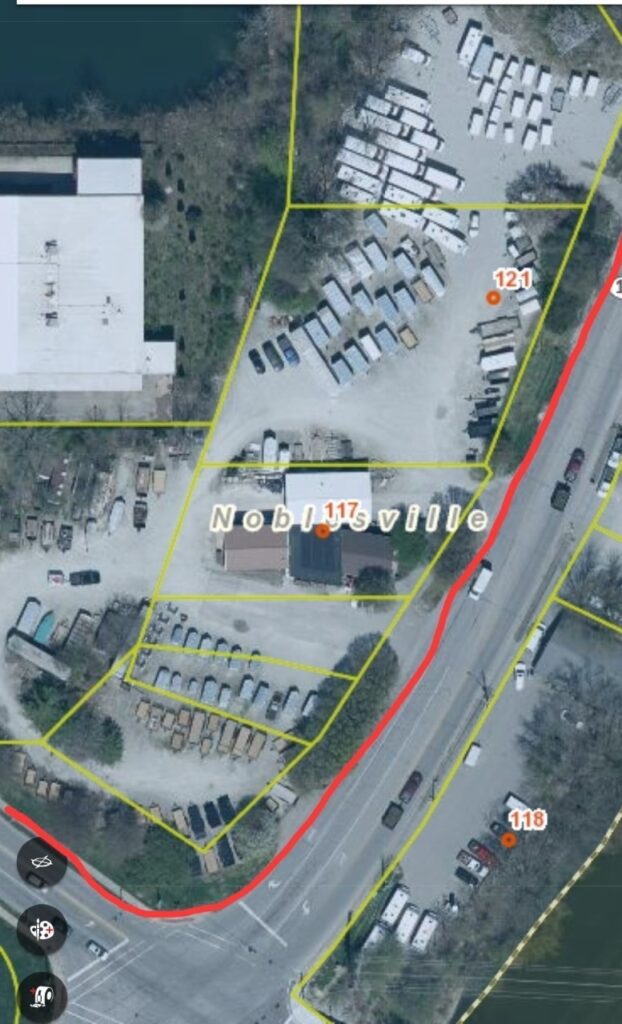Are Political Sign Ordinances Being Selectively Enforced?

Why isn’t the City of Noblesville’s Planning Department removing political signs that are in the right-of-way on the northwest corner of Indiana 19 (Cicero Road) and Logan Street in downtown Noblesville (labeled here in red on the Hamilton County Geographic Information System (GIS))?

“Rules for thee and not for me.”
You might have heard the phrase, which refers to making others follow rules without having to follow rules themselves.
In this column, I’ll be referring to political signs in the right-of-ways — and how some political signs are removed by the City of Noblesville and some are not removed.
Code enforcement is done by the City’s Planning Department, which in February sent out letters to 2022 political candidates, as a reminder of the Unified Development Ordinance standards for the City of Noblesville.
The ordinance states that signs are not allowed on city-owned property, nor within the city’s right-of-way or on utility poles.
That said, I asked: Why isn’t the City of Noblesville’s Planning Department removing signs that are clearly in the right of way, according to both the Hamilton County and City of Noblesville Geographic Information Systems (GIS), specifically signs that are displayed on the northwest corner of Indiana 19 (Cicero Road) and Logan Street in downtown Noblesville?
The right-of-way goes all the way back to the property’s gravel area, according to the GIS, which the Noblesville Planning Department uses religiously.
It appears that most of these political signs are incumbents.
So here is where I ask: Is this an issue of rules for thee and not for me?
Before 8 a.m. Monday, I posed that question and other questions that I have about enforcing the City’s sign ordinance in an email to the Planning Department’s code compliance manager, Justin Hubbard.
He answered my email just after 4 p.m., with a response that read very much like a media spokesperson had written it.
He replied to my question about the political signs in the right-of-way at Ind. 19 and Logan Street, by telling me, “This issue was recently brought to our attention and is under review. Following the 1989 Logan Street project, this property was never replatted so the boundary lines are less clear. On Friday, we located a historical document from the 1989 project that will help us determine specifically how much right-of-way actually exists. We are going out this week to measure and see what is and is not right-of-way. In cases like this, where the right-of-way is in question, the City of Noblesville always sides with property owners unless it is beyond dispute that signs are located in the right-of-way.”
Sounds like selective enforcement in favor of mostly incumbents.
It’s like the city’s hesitant to touch these signs.
The city spent a lot of time and effort and taxpayer dollars measuring, trying to find markers and removing other candidates’ political signs — both large and small — on other private properties in Noblesville that could also be considered “gray areas” of right-of-way on the GIS.
When I asked Hubbard who was responsible for removing political signs, he said, “It is the property owner’s responsibility to place signs in the appropriate locations and to remove any signs placed in the right-of-way.” He went on to say, “The City of Noblesville Planning Department also has the ability to remove signs from the right-of-way as part of our management of municipal property.” Hubbard said, “We attempt to speak to property owners where possible to ensure that they are aware of applicable rules before removing signs in the right-of-way.”
So, why didn’t the City attempt to contact these property owners or political candidates, which I was just mentioning, before spending a lot of time and effort and taxpayer dollars taking down their political signs? And giving them the chance to move the signs out of the right-of-way?
All signs that are removed by the City, that the City sees as right-of-way violations, are taken to “sign jail” inside a gated area behind City Hall, where the candidates can retrieve the signs.
I also asked about the City ordinance that reads: “Signs may not be placed on vehicles or trailers which are parked or located for the primary purpose of displaying said signs.” If this ordinance applies to private property, out of the right-of-way, how is this ordinance not an infringement on First Amendment rights?
The only response, from Hubbard, was, “The City of Noblesville does not regulate the content or message of signs, only the types of signs and the location of signs.”
This obviously refers to political signs.
The U.S. Supreme Court, in a previous court case in Ladue, Mo.,, ruled that the display of political and other types of signs on residential property “is a unique, important, and protected means of communication, and cities and towns cannot restrict the display of such signs.”
So why does the City of Noblesville reprimand some politicians, particularly new candidates, for having signs on vehicles and trailers, and not others?
Again, selective enforcement.
New political candidates don’t have time and energy to fight the City because they’re busy campaigning for office and trying to get their names out there.
All of this shows how important political yard signs have become during our local campaigns.
Political signs cost anywhere from $5 for a small yard sign to a couple hundred dollars for a large 4-by-8-foot sign installed with heavy posts.
Recently, our Hamilton County Commissioners adopted an ordinance to limit political signs at poll locations for early voting on government property. The ordinance limits the number of political signs allowed at each polling place, one sign per voting location on Election Day and no more than two signs per voting location on Early Voting Days.
While political signs, at this time of year, pop up everywhere, like dandelions, the signs are a tradition.
And with an expected low-voter turnout due to the Primary being a non-presidential election, getting the word out is even more vital.
Now, with less than two weeks until the May 3 election, we’ll see if the City’s tape measure is accurate.
– Contact Betsy Reason at betsy@thetimes24-7.com.
